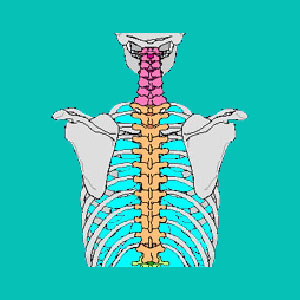
Thoracic degenerative disc disease is a rare condition, due to the natural resistance of the middle and upper back regions to the typical degenerative changes which are part of the aging process. The thoracic spine is not meant to enable significant vertebral level movement. Instead, it is designed primarily as a protective and supportive structure which safeguards our bodily organs and forms the framework of the ribcage. When disc deterioration is located in the thoracic spine, it is usually housed in the very uppermost or lowermost levels, at or near the junctures between the cervical and lumbar frontiers.
This article will examine why disc desiccation is rarely a concern in the middle and upper spinal regions.
Thoracic Disc Disease Facts
The thoracic vertebrae are not called upon to bend and flex in the same manner, or with the same frequency, as the cervical or lumbar vertebrae. The thoracic intervertebral discs are therefore not stressed or worn down by the constant movement suffered by the upper and lower ends of the spine. This allows the thoracic discs to avoid significant degenerative disc disease and remain moist and healthy, even as they age into advanced years.
Severe thoracic DDD is a rare diagnosis which will affect virtually no one with a typical spinal anatomy. Although DDD can be brought about through spinal trauma, or significant structural irregularities, these cases are still rare and thoracic disc deterioration is among the spinal conditions least often blamed for causing considerable upper back symptoms of any type. This is a refreshing change in the often misguided dorsalgia treatment sector.
Thoracic Degenerative Disc Disease Symptoms
Most patients with the rare and symptomatic form of DDD suffer pain from movement in the affected spinal levels. Although the chances of any DDD becoming a real pain concern are unlikely, it might occur in the lumbar or cervical spines, where extended and frequent ranges of motion are commonplace. The thoracic spine is simply not meant to provide this degree of movement across individual vertebral levels and therefore, even the rare case of thoracic DDD should not be inherently painful or problematic.
The diagnosis of thoracic disc degeneration might be made out of exclusion and desperation by a care provider who simply can not find any other scapegoat on which to blame chronic middle and upper back pain.
Thoracic Degenerative Disc Disease Conclusion
Once you learn the facts about degenerative disc disease, it is difficult to take it seriously as a health concern in its expected severities. Thoracic DDD is even less convincing as an actual cause of misery and even the few patients who might be diagnosed with the condition are typically suffering from some other form of middle back pain. Many might be traumatized by recurrent muscular issues which do not show up on spinal diagnostic imaging. Remember, many cases of chronic pain involve the soft tissues and are mistakenly linked to coincidental vertebral abnormalities. Thoracic outlet syndrome is a perfect example.
Ischemia is also a logical explanation for ongoing pain, since this process is not related to injury or spinal degeneration and can affect virtually any area of the body. Dr. John Sarno speculates that many diagnosed DDD patients are really suffering from simple oxygen deprivation back pain and should consider using knowledge therapy for relief, rather than any form of traditional or alternative physical treatment modality. His own personal curative results speak volumes as to the enlightenment of this theory.
Herniated Disc > Degenerative Disc Disease > Thoracic Degenerative Disc Disease




